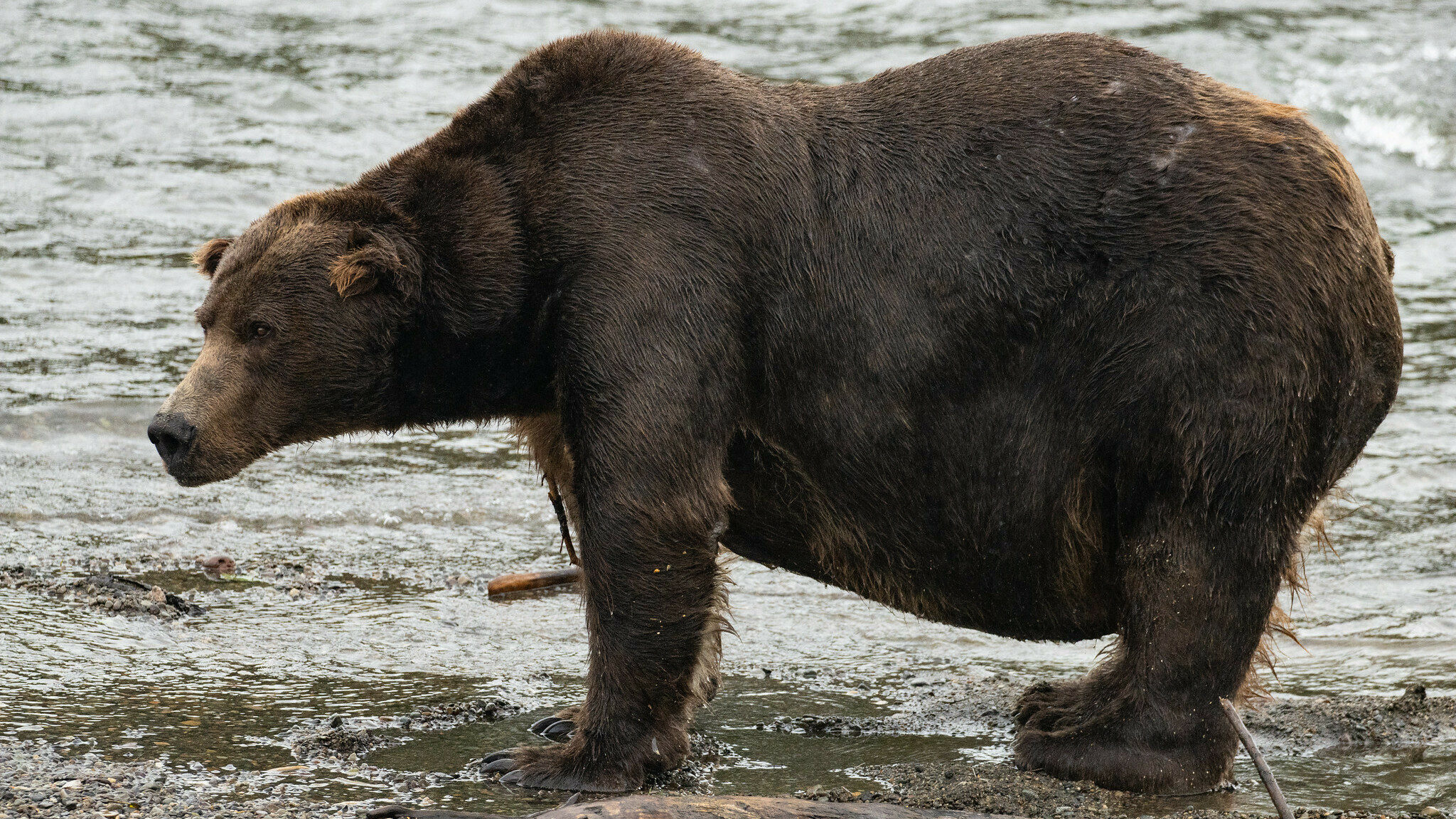32 Chunk Competes in Fat Bear Week: Will He Win?
32 Chunk, known for his girth and a scar on his muzzle, has risen to prominence as one of the most dominant males on the Brooks River. But does he have what it takes to claim victory in Fat Bear Week? (Cory Cravatta/via Katmai National Park & Preserve)
The 2023 Fat Bear Week competition is now officially accepting votes, celebrating the incredible ability of brown bears to pack on weight for their hibernation cycle in Alaska. This remarkable feat is accomplished by devouring copious amounts of fish, and fortunately for these bears, they reside near a thriving sockeye salmon run. “Essentially, those fat stores have to sustain them from late October until June,” explained media ranger Naomi Boak of Katmai National Park and Preserve in an interview with NPR. “We have some of the largest bears on the planet,” Boak revealed. “The big boars, the biggest guys, can reach weights of 1,000 to 1,400 pounds.” However, size isn’t exclusive to the males. Female brown bears also bulk up significantly, even while caring for their cubs.
How Fat Bear Week Works
The 12 brown bears participating in the competition are placed into a bracket, and voters determine who advances to the next round. Voting is open from October 4th to 10th, running from 8 a.m. Alaska time (noon Eastern time) to 5 p.m. Alaska time (9 p.m. Eastern time). “You can follow the bears for years and really get to know their lives and their personalities and their soap operas,” Boak expressed. “We really love that children and teachers follow the bears,” she added. Students can even submit their queries using a Google form.
Which Fat Bear Is Your Favorite?
One of the notable contenders is 128 Grazer, well-known for her tough nature and fierce competition for the best fishing spots. This summer, without the responsibility of caring for cubs, she has grown to an enormous size. (Naomi Boak/NPS) The competition may appear straightforward—simply vote for the fattest bear, right? However, many voters tend to give extra credit to bears that have undergone a dramatic transformation, going from a thin, emaciated state in the spring to becoming the portly rulers of the river by October. Additionally, some bears capture the hearts of fans with their unique quirks and personal stories. Supporters of 128 Grazer, recognized for her large blonde ears, are hoping that this will be her year. As a recent empty-nester, having successfully raised two sets of cubs, she has been able to focus on herself. “She has been putting in the work,” ranger Felicia Jimenez commented when the 2023 bracket was unveiled. “She was quite dainty in early summer, but now she is huge.” Grazer is also known for her proactive defense of her offspring, even preemptively warding off larger male rivals. Consequently, many of her male competitors have kept a respectful distance from her this summer, including 151 Walker, her initial opponent in the bracket. Another bear to watch out for is 32 Chunk. While Chunk has always been on the larger side, he has recently transformed from playfully odd to a contender for dominance. “This 18-year-old boar is a behemoth, shaped like a lightbulb,” Boak remarked. “He’s such an entertaining bear to observe,” stated Mike Fitz, a former park ranger and current board member of the Katmai Conservancy, praising Chunk’s individuality. Of course, there are perennial favorites like past champions 747, 480 Otis, and 435 Holly. On the opposite end of the scale lies 806 Jr., the cub who emerged as the winner of Fat Bear Junior 2023.
How Do Bears Consume So Much Food?
A photo, taken in mid-September, shows 480 Otis in his bulked-up state as he indulges in salmon to build up his body for hibernation. (Naomi Boak/NPS) According to the Department of the Interior, “Once bears enter hyperphagia in late summer, Leptin, the chemical that tells the body it’s full, is suppressed. This allows bears to eat until it’s time to sleep.” In humans, hyperphagia is considered a disorder characterized by “the extreme unsatisfied drive to consume food,” as described in a scientific paper. In bears, however, it is a vital survival strategy as they prepare for months without sustenance. “The most impressive example we’ve observed is 480 Otis, one of our oldest bears and a four-time Fat Bear Week champion. He managed to devour 42 salmon in just five and a half hours,” Boak shared. The summer abundance of food is also the time when young bears bulk up to eventually reach their adult size. “Cubs are born weighing only 1 pound, but by the end of their first year, they can weigh 70 pounds,” explained Boak. “And by the end of their second year, they can tip the scales at 200 pounds.”
A Glimpse into the Wild
“Brooks River stretches a mere mile and a half, but Katmai National Park and Preserve spans over 4 million acres,” Fitz revealed during an interview with NPR’s Weekend Edition Sunday. “This is one of the largest national parks, surpassing any you’ll find in the contiguous United States.” Only a small portion of the park and preserve is accessible via trails and roads. “It’s characterized by expansive lakes and towering volcanoes. The coastline is among the wildest in North America,” Fitz added. “It truly is an extraordinary place.” Copyright 2023 NPR. To see more, visit https://www.npr.org.
Denial of responsibility! Vigour Times is an automatic aggregator of Global media. In each content, the hyperlink to the primary source is specified. All trademarks belong to their rightful owners, and all materials to their authors. For any complaint, please reach us at – [email protected]. We will take necessary action within 24 hours.


